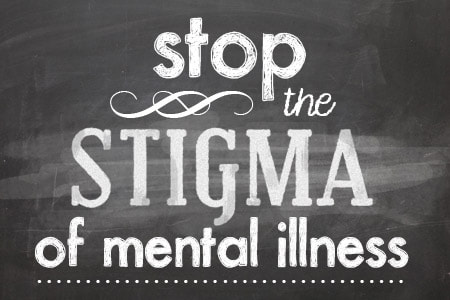|
Workplace Stigmas & Barriers to Receiving Care
by Michelle Castle “Do we have the courage and will to break through the culture of silence, end institutional cover-up, and commit to finding effective ways for the healing profession to care for ourselves as well as for our patients?” 1
What is stigma?
Stigma as a 4-step process that is driven by differentials in power. It includes: distinguishing and labelling of human difference, association of those differences with negative attributes that are linked to stereotypes, which often occurs automatically, separating “us” from “them,” thus othering the person, and status loss and discrimination experienced by the person; this discrimination may be individual or structural (built into institutions like governments, schools, and employers). 2 |
Whether one is dealing with a physical or mental disability, there may be laws in place to keep employers from discriminating against employees, but that doesn’t necessarily mean disclosing mental illness at work is going to feel safe or be free from negative repercussions.
Many of us experience fear about disclosing a need and asking for help. Whether this fear is from judgement, letting others and yourself down, the idea of perfectionism, the feeling of aloneness, workplace passive aggressive or outright discriminating treatment, how we feel about disclosing the need for help has important impact on our ability to receive help.
How do we feel safe to be open in the culture that we work in?
How do we alleviate the fear of effects on our ability to practice and maintaining a professional license?
Many of us experience fear about disclosing a need and asking for help. Whether this fear is from judgement, letting others and yourself down, the idea of perfectionism, the feeling of aloneness, workplace passive aggressive or outright discriminating treatment, how we feel about disclosing the need for help has important impact on our ability to receive help.
How do we feel safe to be open in the culture that we work in?
How do we alleviate the fear of effects on our ability to practice and maintaining a professional license?
A distinct culture
As healers we have a distinct culture surrounding the personal need for help.
“It’s a proud population, It’s not part of the culture. We don’t want to acknowledge vulnerabilities; we’re supposed to be on top of everything.” 3
There are some important factors on why healers have specific vulnerabilities.
“The stress and emotional intensity of caring for others can render physicians less able to care for themselves. Medicine is a tough job, and the responsibility of caring for patients can be an overwhelming job.” 3 Another factor is that in the busy and packed schedules of providing care for others, it is sometimes impossible to have the time to seek treatment for themselves.
As healers we have a distinct culture surrounding the personal need for help.
“It’s a proud population, It’s not part of the culture. We don’t want to acknowledge vulnerabilities; we’re supposed to be on top of everything.” 3
There are some important factors on why healers have specific vulnerabilities.
“The stress and emotional intensity of caring for others can render physicians less able to care for themselves. Medicine is a tough job, and the responsibility of caring for patients can be an overwhelming job.” 3 Another factor is that in the busy and packed schedules of providing care for others, it is sometimes impossible to have the time to seek treatment for themselves.
Fearlessness about death
The most important factor in the higher depression and suicide rate is the “fearlessness about the physical ordeal of death… Humans’ fear of death is deep in our DNA and is a huge barrier to death. It happens every day that people are consumed with the idea of suicide up until the very last instant when that fear kicks in and saves them.”3
This fearlessness is the principal factor in the suicide rates of physicians. “No matter what field of medicine you’re in, you’ve had exposure to physical trauma, and that desensitizes you to blood and injury and toxicity. That is why police officers, firefighters, EMTs, nurses, and members of the military also have higher than average suicide rates.”3
The most important factor in the higher depression and suicide rate is the “fearlessness about the physical ordeal of death… Humans’ fear of death is deep in our DNA and is a huge barrier to death. It happens every day that people are consumed with the idea of suicide up until the very last instant when that fear kicks in and saves them.”3
This fearlessness is the principal factor in the suicide rates of physicians. “No matter what field of medicine you’re in, you’ve had exposure to physical trauma, and that desensitizes you to blood and injury and toxicity. That is why police officers, firefighters, EMTs, nurses, and members of the military also have higher than average suicide rates.”3
How to make it safe to ask for help.
Change is essential – change in our institutions, workplaces, managers, co-workers and ourselves. What is the key?
By working together and openly expressing our vulnerabilities as human beings, we can build awareness among friends, colleagues, and classmates that you are not alone. By emphasizing that seeking help indicates a deep inner strength, not a personal failure or weakness.
Through unified action, we can work together to change individual views and influence system deficiencies that lead to and perpetuate the Culture of Silence.1 If we are in a trusting work environment where we can ask for help and be supported, we can change how our healing professions can become places where we embrace our humanness and accept that getting help creates better healers for others.
Change is essential – change in our institutions, workplaces, managers, co-workers and ourselves. What is the key?
By working together and openly expressing our vulnerabilities as human beings, we can build awareness among friends, colleagues, and classmates that you are not alone. By emphasizing that seeking help indicates a deep inner strength, not a personal failure or weakness.
Through unified action, we can work together to change individual views and influence system deficiencies that lead to and perpetuate the Culture of Silence.1 If we are in a trusting work environment where we can ask for help and be supported, we can change how our healing professions can become places where we embrace our humanness and accept that getting help creates better healers for others.
References:
1. Kishore, S., D. E. Dandurand, A. Mathew, and D. Rothenberger. 2016. Breaking the Culture of Silence on Physician Suicide. NAM Perspectives. Discussion Paper, National Academy of Medicine, Washington, DC. doi: 10.31478/201606a
2. Peterson, A. (2017). Stop Stigma. Mental Health Home. Retrieved on June 22, 2020, from https://mentalhealthathome.org/resource-pages/stop-stigma/
3. Grossman, D. (2016). Reducing the Stigma: Faculty Speak Out About Suicide Rates Among Medical Students, Physicians. Association of American Medical Colleges News. Retrieved on June 22, 2020, from https://www.aamc.org/news-insights/reducing-stigma-faculty-speak-out-about-suicide-rates-among-medical-students-physicians
1. Kishore, S., D. E. Dandurand, A. Mathew, and D. Rothenberger. 2016. Breaking the Culture of Silence on Physician Suicide. NAM Perspectives. Discussion Paper, National Academy of Medicine, Washington, DC. doi: 10.31478/201606a
2. Peterson, A. (2017). Stop Stigma. Mental Health Home. Retrieved on June 22, 2020, from https://mentalhealthathome.org/resource-pages/stop-stigma/
3. Grossman, D. (2016). Reducing the Stigma: Faculty Speak Out About Suicide Rates Among Medical Students, Physicians. Association of American Medical Colleges News. Retrieved on June 22, 2020, from https://www.aamc.org/news-insights/reducing-stigma-faculty-speak-out-about-suicide-rates-among-medical-students-physicians

